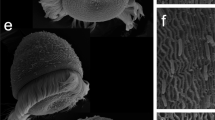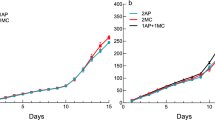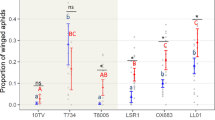Abstract
FOR many plants, fungi and sessile invertebrates, the availability of habitable space often limits their size, reproductive output and survival. Intraspecific and interspecific variation in the ability to compete for space is common1–3, but the way in which competitive ability is regulated remains largely unknown. We describe here a system of intraspecific competition in the hydroid Hydractinia symbiolongicarpus in which the principal mechanisms underlying variation in competitive ability have proven amenable to experimental analysis. Competitive interactions can be aggressive, involving the induction of a specialized fighting organ called a hyperplastic stolon, or non-aggressive, in which no hyperplastic stolons are produced. Colonies display continuous variation in the ontogenetic appearance of tissues that differ in their competence to be induced to produce hyperplastic stolons. We find that the outcome and kind of competitive interaction between strains are predictable given knowledge of their morphologies. In this hydroid, complex competitive behaviour arises from a coupling of discrete morphogenetic potential of differing tissue types with continuous variation in the ontogenetic and astogenetic appearances of these tissues.
This is a preview of subscription content, access via your institution
Access options
Subscribe to this journal
Receive 51 print issues and online access
$199.00 per year
only $3.90 per issue
Buy this article
- Purchase on Springer Link
- Instant access to full article PDF
Prices may be subject to local taxes which are calculated during checkout
Similar content being viewed by others
References
Jackson, J. B. C. in Biotic Interactions in Recent and Fossil Benthic Communities (eds Tevesz, M. J. S. & McCall, P. L.) 39–120 (Plenum, New York, 1983).
Buss, L. W. in Community Structure (eds Case, T. & Diamond, J.) 517–536 (Harper and Row, New York, 1986).
Keddy, P. Competition (Chapman and Hall, London, 1989).
Buss, L. W. & Yund, P. O. J. mar. biol. Ass. UK 69 (in the press).
Yund, P. O., Cunningham, C. W. & Buss, L. W. Ecology 68, 971–982 (1987).
Buss, L. W. & Yund, P. O. Ecology 69, 646–654 (1988).
Yund, P. O. & Parker, H. M. J. exp. mar. Biol. Ecol. 125, 63–82 (1989).
Hauenschild, C. Wilhelm Roux. Arch. EntwMech. Org. 147, 1–41 (1954).
Hauenschild, C. Z. Naturforsch. 11, 132–138 (1956).
Buss, L. W., McFadden, C. S. & Keene, D. R. Biol. Bull. 167, 139–158 (1985).
Buss, L. W. & Shenk, M. A. in Defense Molecules (eds Marcholonis, J. J. & Reinisch, C.) (A. R. Liss, New York) (in the press).
Müller, W. A. Wilhelm Roux. Arch. EntwMech. Org. 155, 181–268 (1964).
Ivker, F. B. Biol. Bull. 143, 162–174 (1972).
Lange, R., Plickert, G. & Müller, W. A. J. exp. Zool. 249, 284–292 (1989).
McFadden, C. S., McFarland, M. J. & Buss, L. W. Biol. Bull. 166, 54–67 (1984).
Blackstone, N. W. & Yund, P. O. Paleobiology 15, 1–10 (1989).
Boardman, R. S. & Cheetam, A. H. in Animal Colonies (eds Boardman, R. S., Cheetam, A. H. & Oliver, W. A. Jr) 121–222 (Dowden, Hutchinson and Ross, Stroudsburg, Pennsylvania, 1973).
Maynard Smith, J. Evolution and the Theory of Games (Cambridge University Press, 1982).
Winer, B. J. Statistical Principles in Experimental Design (McGraw-Hill, New York, 1971).
Falconer, D. S. Introduction to Quantitative Genetics (Longman, New York, 1981).
Blackstone, N. W. & Buss, L. W. Evolution (in the press).
Author information
Authors and Affiliations
Rights and permissions
About this article
Cite this article
Buss, L., Grosberg, R. Morphogenetic basis for phenotypic differences in hydroid competitive behaviour. Nature 343, 63–66 (1990). https://doi.org/10.1038/343063a0
Received:
Accepted:
Issue Date:
DOI: https://doi.org/10.1038/343063a0
This article is cited by
-
The Hydractinia allorecognition system
Immunogenetics (2022)
-
Competitive equivalence maintains persistent inter-clonal boundaries
Oecologia (2005)
-
Ontogenetic shifts in fusion?rejection thresholds in a colonial marine hydrozoan, Hydractinia symbiolongicarpus
Behavioral Ecology and Sociobiology (2004)
-
Plastic inducible morphologies are not always adaptive: The importance of time delays in a stochastic environment
Evolutionary Ecology (1996)
-
The settlement and growth of Sertularia cupressina (Hydrozoa, Sertulariidae) in Langstone Harbour, Hampshire, UK
Hydrobiologia (1991)
Comments
By submitting a comment you agree to abide by our Terms and Community Guidelines. If you find something abusive or that does not comply with our terms or guidelines please flag it as inappropriate.



